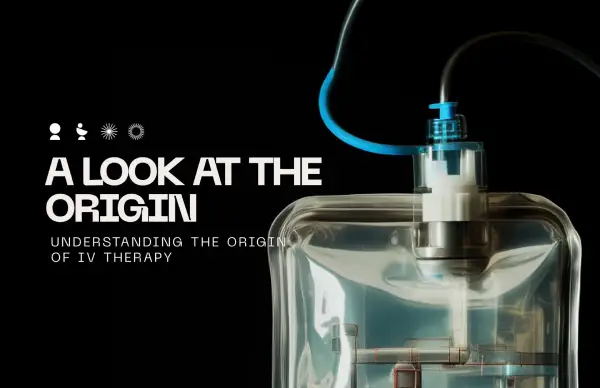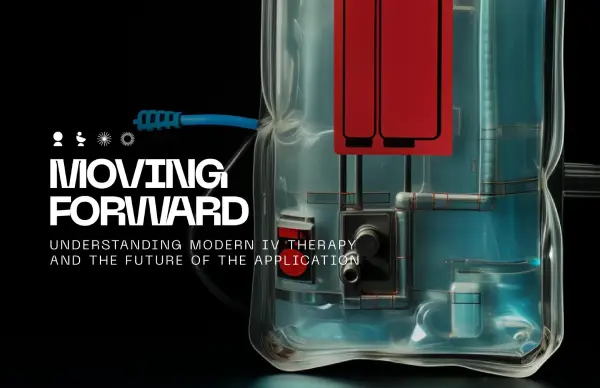Blog
The history and future of IV therapy

Contents
What is IV therapy?
Uncovering the background of IV therapy
Modern IV therapy applications
Does IV therapy have a sustainable future?
Get satisfactory results with personalized IV therapy
Is IV therapy another hype, or a proven solution? Does it have a solid track record of success?
Intravenous therapy boasts a rich history tracing back many decades. It’s stood the test of time and continues to evolve with better efficiency. It started as a simple experiment that later birthed significant milestones.
This therapy is traditionally applied via blood transfusions. Modern uses vary from vitamin infusions to water drips, thanks to rapid innovation.
Does intravenous therapy have a future? How will medical advances redefine it? Is it agile enough to shift with emerging trends? Dive in for answers to these and more questions as we unfold the journey of this breakthrough remedy.
What is IV therapy?
IV therapy is a treatment that delivers fluids directly into your veins. The “IV” abbreviation stands for intravenous, which means administering medication via a vein.
This technique offers faster water, nutrient, and vitamin access to your circulatory system. It’s a swifter alternative to minerals and vitamins from supplements and foods.
Nutrient absorption via the stomach varies by individual. It depends on factors like metabolism, age, health status, and genetics. IV administration could be the ultimate solution to beat this setback.
Increased minerals in the bloodstream translate to faster uptake into cells and mitochondria. Scientists believe this quick absorption benefits the immune system. It may help remove toxins and improve skin health.
Doctors typically use an IV line that connects to your vein for this therapy. This link helps the body absorb more fluids quickly by bypassing the gastric system. Your physician inserts your veins with a cannula attached to a tube. An IV bag carries the fluids that drip into the veins.
Popular applications of intravenous therapy and hydration include the treatment of:
- Post-exercise severe dehydration by delivering fluids
- Blood loss through transfusion
- Malnutrition through nutrient administration
- Pain by delivering pain relief
Other uses of this treatment include improving athletic performance and anti-aging efforts. It offers three main benefits that most patients seek:
- Efficiency. This therapy doesn’t interact with the digestive system. It delivers more medication per unit of time than most treatments. It’s easier to treat the target organs quickly.
- Convenience. A cannula can stay intact for several days once inserted. It allows your doctor to offer regular treatment without subsequent needle insertions.
- Speed. This treatment leverages the direct administration of medication. It promotes fast patient recovery, especially during emergencies like severe dehydration.
Remember, the wrong application of intravenous therapy may pose a few side effects. You could experience allergic reactions, blood clots, deep-skin swelling, or skin necrosis. Only seek this treatment from a qualified professional. Be careful who accesses your bloodstream.
What is the process of IV therapy at LIVV Natural?
Choosing LIVV Natural gives you access to unmatched personalized solutions. Our naturopathic clinic perfects the art of listening to understand unique customer needs. After initial consultations, our IV therapy typically takes these steps:
- Your naturopathic doctor selects a vein to insert the cannula. Common insertion points include the wrist, forearm, foot surface, or the back of your hand. The physician may use an ultrasound to guide the needle if your veins are untraceable.
- The doctor sanitizes the insertion area once they find a suitable vein. They then insert a fine needle linked to the cannula. Holding the cannula in place may require adhesive tape.
- Your doctor connects the cannula to the IV using a specialized tubing mechanism.
- The doctor checks the cannula regularly during infusion. This follow-up inspection ensures proper IV flow while preventing pain and swelling.
- Your doctor disconnects the cannula from its tubing after a complete infusion. They then eject it from the vein.
- The doctor applies pressure on the insertion wound to minimize bleeding. They may patch up the treatment area with cotton and adhesive tape.
An IV infusion session may take 20 minutes to an hour, depending on the fluids administered. The size of a patient’s veins also matters.
Uncovering the background of IV therapy
When and where was IV invented? Maryland-based Dr. John Myers is among the pioneers of intravenous nutrient therapy. He delivered the first vitamin infusion in the 1970s. His enthusiastic research led to the widespread promotion of this treatment technique.
Dr. Myers’ legacy lived on through his colleagues after he passed on in 1984. They developed an intravenous therapy named “Myer’s cocktail” in his honor.
The ingredients of “Myer’s cocktail” included:
- Vitamin C
- Several B vitamins
- Calcium
- Magnesium
These elements lacked standardization from the onset. Their formulation birthed variations that holistic medics still apply to date. “Myer’s cocktail” initially targeted headaches and migraines. Some physicians also found it effective for depression, fibromyalgia, and chronic fatigue.
Over time, most modern doctors alter the volumes of the vitamins in the original “Myer’s cocktail.” Some call the new version the “modified Myer’s cocktail.” Others even personalize doses to suit older adults and children.
Through continuous improvement, intravenous therapy delivers better, faster results in ideal conditions. Many physicians traditionally recommend it to people who:
- Can’t get enough minerals and vitamins due to less food intake
- Can’t absorb nutrients due to an illness
Modern IV therapy applications
The fast-paced innovation in the medical world unfolds new IV applications. This therapy now goes beyond treating mineral and vitamin deficiencies. It’s ideal for enhancing overall wellness to complement other natural solutions.
Below, we highlight the most trending modern uses of IV therapy.
High-dose vitamin C IV therapy
Did you know IV vitamin therapy is more effective than oral vitamin ingestion? Oral vitamins break down in the stomach and digestive tract. They have a 50% absorption rate. Vitamin administration through IV drips has a 90% absorption rate.
IV vitamin therapy is dynamic. Talk to your doctor about your deficient minerals to avoid deviating from your goals. The most common ingredients in your drip are B vitamins, vitamin C, calcium, and magnesium. Others may include amino acids and antioxidants like glutathione.
These drips could feature a single vitamin or a mixture of vitamins and minerals. Your doctor dilutes the contents with sterile water per the “Myers cocktail.” Understanding your body composition before treatment is imperative.
Vitamin C is a crucial natural element, but the body can’t make its own. This water-soluble supplement helps in bone, cartilage, skin, and blood vessel formation. It can also act as an antioxidant to support the immune system. It’s common in fruits and vegetables.
A study observed the beneficial effects of high doses of vitamin C in young adults. The subjects took 1250 mg of the vitamin daily for eight weeks.
The aftermath was enhanced antioxidant efficiency of serum. The elevated vitamin C levels also increased the anti-inflammatory activity of the blood.
High-dose vitamin C plays a role in collagen production, which promotes skin health. It’s also essential for wound healing through its repair function.
Some reports claim IV vitamin C could benefit cancer patients. It improves their quality of life and reduces cancer-triggered side effects.
At LIVV Natural, the typical vitamin C dose is 200 mg once daily for about a week. Sometimes, IV doses average 10–100 g based on the underlying ailment. Discuss with your doctor the appropriate amounts to take and the ideal schedule.
Alpha lipoic acid (ALA) IV therapy
Alpha lipoic acid (ALA) is a remedy that treats chronic illnesses linked to oxidative stress. It acts as an antioxidant to prevent metabolic dysfunction and diabetic neuropathy.
This acid occurs in all body cells and turns carbohydrates into energy. It also supports glucose uptake by body cells.
Intravenously administering ALA may have some therapeutic benefits. Scientific evidence shows that taking 600 mg of ALA daily improves neuropathic symptoms and deficits. This antioxidant could alleviate nerve pain and inflammation in diabetic patients.
The body absorbs 30–40% of oral ALA supplementation, especially on an empty stomach. IV infusion may deliver higher percentages due to direct blood contact.
While ALA doesn’t pose adverse side effects, higher doses don’t provide extra benefits.
Ozone IV therapy
Ozone therapy employs medical-grade ozone gas to boost oxygen levels in your body. Higher oxygen amounts enhance immunity and promote healing.
This treatment triggers cell regeneration to repair or replace damaged cells. The three popular methods to administer ozone are:
- Intravenously
- Intramuscularly
- Direct tissue application
Intravenous ozone application involves mixing the gas with your blood. The doctor dissolves ozone gas in a sample of your blood. They then inject the infused blood back into your body through IV therapy.
Several studies claim ozone therapy inactivates some viruses, HIV, and cancer. Further evidence suggests it can also treat musculoskeletal disorders like:
- Rheumatoid arthritis
- Osteoarthritis
- Hip bursitis
- Lumbar facet joint syndrome
NAD+ IV therapy
NAD+ is a naturally occurring coenzyme that supports cellular repair and energy production. The applications of NAD+ IV therapy typically include:
- Boosting metabolism
- Slowing the aging process
- Improving brain function
- Shielding cells from oxidative damage
- Enhancing mitochondria function
Injecting this coenzyme directly into the blood produces almost instant results. It stimulates mitochondrial activity, resulting in an energy boost post-treatment. Its lasting effects range from reduced fatigue to heightened mental clarity.
This therapy may take up to two weeks, depending on your supplementation goals.
Ketamine IV therapy
Ketamine is an FDA-approved anesthesia medicine that initially treated wounded soldiers. While some folks use it recreationally, it’s safer within controlled medical settings. This remedy can sedate, cause hallucinations, or incapacitate with inappropriate use.
Doctors may apply ketamine for off-label purposes to induce temporal sedation when:
- Attending to joint dislocations
- Addressing fractures
- Repairing painful wounds in children
Don’t let mood swings overstay their welcome. IV ketamine is a popular remedy for stubborn depression due to its euphoric effects. Anecdotal evidence shows it produces positive results when administered in correct doses.
Does IV therapy have a sustainable future?
The medical world has no shortage of innovations. The future of IV therapy is brighter thanks to its growing awareness and application. Some of the technologies emerging with this treatment include:
- Vein-finding technology. Efficiency is a critical treatment aspect for modern patients. They prefer spending the least time in medical procedures and getting on with life. IV therapists can use this device to project real-time images of a patient’s veins.
- Advanced infusion pumps. These devices automate the process of IV administration. They offer an extra safeguard by releasing precise amounts of fluid per hour. Controlled doses minimize overdosing risks.
- Telemedicine. The time is ripe for remote patient monitoring in IV infusions. Your doctor can guide IV administration at your home’s convenience. This approach cuts in-person visits, helping you save time for other crucial tasks.
- Artificial intelligence (AI) integration. AI can empower naturopathic doctors to make more informed decisions. Machine learning algorithms accurately analyze patient data to predict optimal solutions and doses.
Get satisfactory results with personalized IV therapy
IV therapy is a fundamental pillar in the medical world. It adds speed, convenience, and efficiency to the administration of treatment.
Doctors can directly and safely deliver medication into the bloodstream via the veins. What better way to bypass the digestive system for faster results?
This treatment addresses numerous issues, from dehydration to vitamin deficiency. It’s common in blood transfusion, nutrient supplementation, and oxygen replenishment.
Intravenous therapy is a resilient invention. It continues to evolve from the early days of “Myers cocktail.”
Modern infusions exceed the initial limitations by incorporating a broader range of ingredients. It covers, among others, high-dose vitamin C, ALA, NAD+, ketamine, and ozone drips.
Do you want personalized intravenous therapy? Look no further than LIVV Natural. We’re your one-stop naturopathic clinic for holistic solutions. Our methods are efficient and backed by ultramodern technologies. Contact us today to discuss your unique goals.
Author: Dr. Jason Phan NMD – Founder of LIVV Natural – Anti-aging – regenerative medicine – peptide therapy


